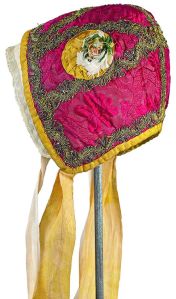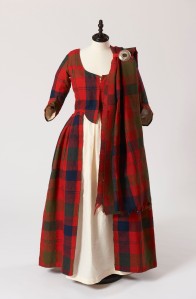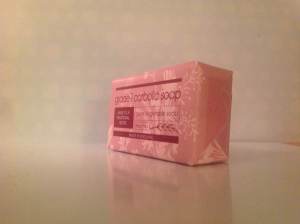Dr Sally Holloway recently completed her PhD on the material culture of romantic love in eighteenth-century England at Royal Holloway, University of London. She was one of the organisers of a recent conference about emotional objects, on which she reports here.
Emotional Objects: Touching Emotions in Europe 1600-1900
Institute of Historical Research, 11th-12th October 2013
The Emotional Objects conference aimed to bring together scholars from a wide range of disciplines to discuss what historians can learn about emotions in history using material culture. Many of our speakers were curators, joining us from the V&A and Museum of Freemasonry in London, Norfolk Museums and Archaeology Service, National Museums Scotland, Den Gamle By in Denmark, and the Hirschsprung Collection in Copenhagen. We were thrilled to be able to unite scholars from across the world, who travelled from America, Australia, Canada, Finland, the Netherlands and Russia to participate in the conference.
This report is based on my reflections from one strand of panels, as my co-organiser Alice Dolan had to depart for America to undertake a fellowship at the Winterthur Museum shortly after the conference. Most papers from both strands will soon be available to listen to on the History Spot website.
The conference opened with a keynote by John Styles, who began our discussion of emotional objects using Proust’s evocative description of the madeleine in Á La Recherche du Temps Perdu:
I raised to my lips a spoonful of the tea in which I had soaked a morsel of the cake…this new sensation having had on me the effect which love has of filling me with a precious essence; or rather this essence was not in me, it was myself. I had ceased now to feel mediocre, accidental, mortal.[1]
Styles described how the taste of the madeleine has been the main focus of scholarship, rather than its emotional properties. The ‘new sensation’ aroused by the madeleine demonstrates how the emotional meanings of objects change significantly over time, as they can emote at one point and not at another. Styles noted that the history of emotions has largely been based in text not objects, chiefly focusing on how people wrote about their feelings and how such descriptions changed over time.
One of the most deeply emotional collections of objects to survive are stored in the Foundling Hospital billet books at the London Metropolitan Archives, recently brought to life by the exhibition Threads of Feeling at the London Foundling Museum. While such hospitals operated across Europe, there was significant variation in the tokens selected by mothers to identify their infants and encapsulate their emotions. Surviving tokens in France possessed a more explicitly religious character, with depictions of the flaming sacred heart granting them an extra protective power.
Styles argued that textiles provided the most emotional material available to mothers, as their infants had touched, worn and soiled the fabric. Ribbons were also frequently left with infants, which provided the very currency of love and romance. The notion of textiles as particularly emotional objects provided a recurring theme over the next two days. As Claire Lerpiniere argued in her paper on identity and materiality, textiles are historical documents created at particular stages in people’s lives; we are swaddled within the folds of textiles right from birth, and we are eventually buried in them. As noted by Michèle Plott in her study of arranged marriages in France 1860-1885, textiles such as fur coats and cashmere shawls provided the central sign that a woman’s life was about to change.
A range of sources were used by speakers to access emotional ties to objects, including court records, diaries, novels and paintings. Hanna Kietäväinen-Siren explored the ‘language game’ of emotions (Bourke) using the words spoken by lovers in court in early modern Finland. Tara MacDonald drew upon Victorian sensation fiction such as Wilkie Collins’ The Woman in White (1860) to approach hair as a loaded symbolic object revealing how humans can become ‘things.’ Tove Engelhardt Mathiassenanalysed protective strategies hidden in Danish Christening garments by combining close analysis of the construction of textiles with a study of colours such as red used to depict infants in art. The red christening cap below was made for an infant boy in the late eighteenth century, and had added symbolic protection from gold lace covering all of the seams.

Silk christening cap with gold lace and yellow silk ribbons, photograph © Thomas Kaare Lindblad and Den Gamle By, Aarhus, Denmark.
Various methodologies were proposed by speakers as a means of accessing the emotional properties of objects in history. Antonia Brodie presented an in-depth history of a single sheet donated to the V&A in 2006 using dates and initials embroidered in cross-stitch over a 130-year period. Emily Taylor traced the history of gowns including the ‘Fraser Wedding Dress’– a red tartan dress which has been used as a bridal gown by a single Scottish family since 1785, and was last worn in 2005. Geoffrey Cantor explored the history of the term ‘wonder’, specifically in reactions to the Great Exhibition in 1851. Sarah Ann Robin utilised a five-pronged methodology for interpreting surviving love tokens in museums and private collections (Material, Function, Design, Known Provenance and Quantitative Analysis) allowing her to approach each object she encountered in the same way.
The ‘Fraser Wedding Dress’ © Inverness Museum & Art Gallery, INVMG.00.164
Robin noted that she had tried to physically handle every item studied within her thesis. The idea of touching and handling objects both by historians and individuals in history provided a recurrent conference theme. In my own paper I combined letters, diaries, objects and prints to explore the ritualised process of touching, smelling, kissing and gazing at love tokens in eighteenth-century England, arguing that this provided a key means of conceptualising and processing a person’s emotions. Victoria Kelley analysed narratives surrounding the cleaning of surfaces in Victorian and Edwardian homes; the fanaticism of cleaning routines, anxiety over germs, and delight over gleaming surfaces. It was possible to clean a surface too much, as over-polishing could be a terrible faux pas in making a surface slick and tacky. Delegates discussed at length the dichotomy between handling andnot handling objects. In the discussion following the Keeping Textiles panel, it was suggested that the value of certain items in museums is created through a kind of public stasis, as the object not doing anything creates a new kind of meaning through its preservation.
The way in which objects were depicted in history also reveals how they were constructed and valued emotionally. Niall Atkinson and Susanna Caviglia described how touching stones in paintings of eighteenth-century Rome anchored artist and viewer, with painting landscapes providing a way of unlocking the past. Johanna Ilkmannus presented handiwork as part of aristocratic sociability for elites in eighteenth-century Europe, as demonstrated by François-Hubert Drouais’ portrait of Madame de Pompadour at her tambour frame in 1763-4. Anna Schram Vejlby argued that the Danish bourgeoisie in the early nineteenth century used depictions of women knitting as a symbol of their success, exemplified by portraits such as Familien Waagepetersen by Wilhelm Marstrand (1836).Joanna Crosby described how orchard motifs evoked the pre-Industrial world in Victorian art, such as Henry Herbert La Thangue’s oil painting Cider Apples from 1899.
The pungent carbolic soap handed around by Juan Manuel Zaragoza Bernal
Space provided a recurring theme of the conference. Joelle Del Rose outlined how William Beckford (1760-1844) meticulously purchased and arranged material goods to create a ‘fairy world’ for sexual liaisons at home. By hiring decorators to transform his domestic space, Beckford created a seductive delirium where monotony of any kind was banished. Juan Manuel Zaragoza Bernal investigated Victorian objects such as carbolic soap and slipper bedpans to argue that new mass produced objects of care created particular material conditions when caring for someone. In a similar vein, Mark Dennis presented freemasonry as a ‘dramatic theatrical space’ created through objects such as stone from King Solomon’s Temple, which remains a feature of every Master’s Badge. Objects could also provide emotional spaces in their own right, with Bridget Millmore describing eighteenth-century coins as portable sites which people could go to when thinking of others.
The conference was characterised by a supportive atmosphere, with each panel ending with at least half an hour of open discussion between speakers and delegates. One such discussion concerned the emotional process of donating objects to museums, which certain people use as a way to memorialise deceased relatives. However every institution operates fixed criteria for the objects they collect, meaning that many items unfortunately have to be sent back to families. Curators described the people left in tears as their family heirlooms were rejected by a museum, wounded by the idea that ‘your value is not value enough.’ Others told of individuals donating valuable objects to museums to keep them away from certain relatives, driven by resentment of their families.
An ‘Ex Axe’ from Berlin donated to the Museum of Broken Relationships in 1995. Image courtesy of MBR by Ana Opalić.
An intriguing collection of ‘broken’ objects can be viewed at the touring Museum of Broken Relationships, which anonymously displays the material ‘ruins’ of unhappy love. One such item is an axe used by a spurned lover in Berlin to chop the furniture of an ex-girlfriend into small fragments of wood. Delegates also described the ‘curse of the boyfriend jumper’, which holds that women should avoid investing time and effort in knitting for boyfriends before marriage, as the ‘sweater curse’ will lead to an untimely break up.
Our closing discussion saw delegates discussing what exactly an emotion is, as the subtleties and ambiguities of emotions can often be difficult to categorise. As William Reddy notes in his Navigation of Feeling, ‘Disagreements persist, uncertainties abound.’[2] It was recognised that certain objects in history were used to ‘fix’ or stir particular emotions, such as using romantic gifts to inspire love, or objects to apologise and avoid anger. In many cases the withholding of an object could be just as significant as bestowing it, with women in early modern Finland who had sex before marriage not permitted to wear bridal crowns. Delegates questioned whether the ability of objects to be personalised could be the key to their emotional capacity.
Certain objects were conspicuous in their absence, including monuments, drones, ships, railways and cars, in part due to conference papers ending c. 1900. The conference concluded with a discussion of the possibilities offered by digital humanities scholarship, as museums are increasingly putting huge volumes of their collections online.
To aid subsequent research, we have created a collaborative reading list of key texts on objects and emotions for future scholars. Podcasts of papers will soon be added to the Emotional Objects blog, where we are also creating an ‘archive’ of emotional objects in history.
Thank you to Den Gamle By, Inverness Museum & Art Gallery, Juan Manuel Zaragoza Bernal and the Museum of Broken Relationships for permission to reproduce the images in this post (which first appeared on the Emotional Objects blog).
Follow Sally on Twitter @sally_holloway
[1] Marcel Proust, Remembrance of Things Past, Vol. I, trans. CK Scott Moncrieff (Ware; Wordsworth Editions, 2006), p. 61.
[2] William M. Reddy, The Navigation of Feeling: A Framework for the History of Emotions
(Cambridge, 2001), p. ix.



